Resident Fish in the
Columbia River Basin
Fish and Wildlife Program
The Columbia River Basin’s watershed is an intricate web of mutually dependent organisms that nurture and sustain each other. The construction and operation of dams on the rivers caused widespread changes to the basin by blocking fish passage, slowing river flows, degrading water quality, and disrupting the natural processes of this complex habitat.
For fish that live their entire lives in the river — called resident fish — the Council’s Columbia River Basin Fish and Wildlife Program includes actions to mitigate the impact of the region’s hydro system on them, as well as salmon and steelhead. The Council’s program considers all fish and wildlife as essential to a thriving ecosystem.
In 2020, the Council recommended 44 projects for resident fish around the basin for funding to the Bonneville Power Administration. Most of the actions are in the blocked area of the basin and focus on 1) mitigating the loss of habitat and ability of fish to access spawning and rearing areas; and 2) using hatchery programs for harvest. As technology advances, fish and wildlife managers are also evaluating the feasibility of returning anadromous fish to areas blocked by dams.
Habitat Preservation
The program aims to improve healthy habitat, especially in protecting key stream reaches from hydropower development. The program helped states and tribes acquire more than 400,000 acres for resident fish and wildlife, including conserving riparian habitat in Montana for sensitive species like bull trout.
For projects like the Chief Joseph Kokanee Enhancement project, more effort is going into the suppression and eradication of non-native invasive species, like northern pike.
In some cases, restoration efforts are coupled with harvest opportunities in closed ponds to reduce fishing pressure while habitat recovers. These projects are coupled with education and community engagement to make them successful cultural fisheries.
Hatcheries
Twelve hatcheries and ponds are managed through the Council’s Fish and Wildlife Program to mitigate anadromous fish losses and impacts to resident fish from hydropower development and operations. Hatchery programs work to recover species like the endangered Kootenai River white sturgeon; reintroduce burbot into the lower Kootenai River; and support efforts to recover westslope cutthroat trout in Montana. Another important purpose is to increase resident fish harvest of trout and sturgeon in Lake Roosevelt above Grand Coulee Dam, as well as provide resident fish for harvest on the reservation for the Shoshone Paiute Tribe, Nez Perce Tribe, Coeur d’Alene Tribe, and the Burns Paiute Tribe.
Hatchery programs in Lake Roosevelt produce rainbow trout for sport and tribal subsistence fisheries that also improve ecological conditions in Lake Roosevelt and Banks Lake.
Learn more about the Council's resident fish hatchery programs.
Research
Ongoing evaluation of hydropower impacts, the effectiveness of habitat investments, and the performance of hatchery programs is a key component to successful programs.
For example, collaborative work is underway in the Upper Columbia to collect fishery, habitat, and water quality data to inform management actions and research.
In addition to ongoing work to address impacts, managers are monitoring new problems that could affect the region’s investments. Work to prevent northern pike, a highly invasive species, from overwhelming Lake Roosevelt and the Pend Oreille River is one example of this.
Key Resident Fish
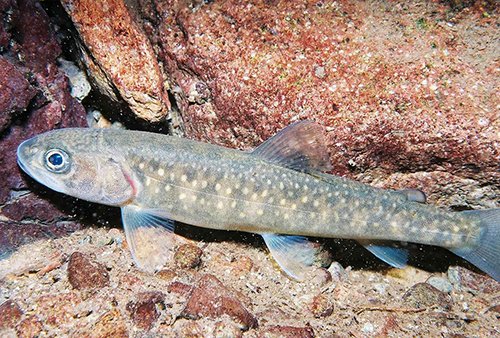
|
Bull TroutBull trout are a char native to the Pacific Northwest and Canada. All populations of the bull trout were listed as Endangered in 1998 and reclassified as Threatened under the Endangered Species Act in 1999. They are usually found in deep pools of large, cold mountain rivers and lakes. Bull trout are a migratory species. Some of these fish might spend their entire lives in the same stream or they may move to larger bodies of water to overwinter and then migrate to smaller streams to reproduce. On the other hand, some bulltrout are born in fresh water and then migrate to the ocean for their adult lives and return to fresh water to reproduce. (For more, see the U.S. Fish and Wildlife Service.) The Kalispel Tribe is working to restore upstream passage of bull trout at Albeni Falls Dam, reconnect local bull trout populations, and provide access to habitat that has been fragmented. The Idaho Department of Fish and Game implemented a predator suppression effort in Lake Pend Oreille to prevent food web collapse and sustain fish. The effort has a robust monitoring program. The Burns Paiute Tribe is working to remove non-native brook trout to promote the recovery of native bull trout. The Confederated Tribes of the Warm Springs Reservation identifies habitat restoration needs and areas where extirpated populations can be re-established. |
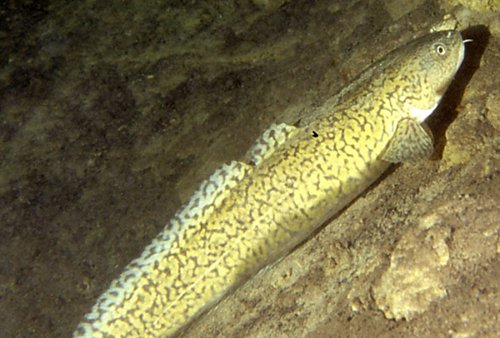
|
BurbotThe burbot is native to most of Canada and the northern United States and is found in all three major river drainages in Montana. Burbot, also known as ling, are usually found in larger streams and cold, deep lakes and reservoirs. They are peculiar in that they spawn during winter under the ice. They are also largely nocturnal and have an enthusiastic following among fishermen. Burbot are voracious predators and opportunistic feeders. Like other codfish, burbot have livers that contain oils high in vitamins A and D. (For more, see the Montana Field Guide.) While native to Idaho’s Kootenai River, burbot were functionally extinct. The Kootenai Tribe and the University of Idaho discovered how to rear them in captivity. Their hatchery is the first successful aquaculture program for burbot. In Lake Roosevelt, efforts to conserve and enhance burbot populations are designed to provide subsistence and recreational harvest opportunities. Stock assessment data and recruitment and early life history information is being gathered and evaluated to identify limiting factors. |
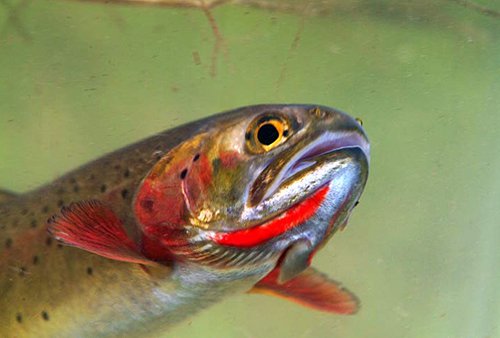
|
Cutthroat TroutCutthroat trout are freshwater fish in the salmon family. Although inhabiting clear, cold streams in their native range in western North America, this species is becoming a popular sport fish stocked below federal water projects in the Southeast. (For more, see U.S. Fish and Wildlife Service.) The Coeur d’ Alene Tribe is working to restore and protect the remaining westslope cutthroat trout populations by targeting watersheds and managing predators. Since 2004, the Idaho Department of Fish and Game has implemented an intensive conservation management strategy in the South Fork Snake River to support one of the few remaining functioning populations of Yellowstone cutthroat trout, a culturally significant species to the Shoshone Bannock Tribes. |

|
White SturgeonWhite sturgeon are found in Idaho, Montana, Washington, Oregon, and British Columbia. They are an ancient fish affected by the construction and operations of dams that have altered natural flows, reduced river productivity, and impaired ecological functions. (For more, see our White Sturgeon page, also Idaho Fish and Wildlife.) The Columbia Basin once supported a large and productive population of white sturgeon, with access to hundreds of miles of the Columbia and Snake rivers from the Pacific Ocean upstream far into Idaho and Canada. Sturgeon populations in the Columbia River system have declined from overfishing, dam construction, dam operations and flow regulation, habitat loss, and habitat fragmentation. The Yakima Nation is working to develop culture techniques and release juvenile sturgeon to restore existing stocks and to re-introduce sturgeon to areas in the mid-Columbia River. The fish will be reared on the Yakama Reservation at the Yakama Nation Sturgeon Hatchery (see NY Times story). The Kootenai Tribe of Idaho’s program fosters healthy, productive populations of sturgeon, burbot, and other native fish. The Idaho Department of Fish and Game collects data to inform mitigation strategies. Conservation aquaculture has been used to preserve and protect genetic diversity. |
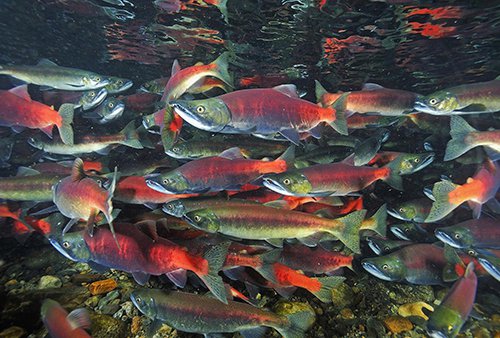
|
KokaneeKokanee are the non-anadromous (non-migrating) form of sockeye salmon and like all salmon, they die after their first spawning. They have a limited range and are endemic to Oregon, Washington, Idaho, Alaska, and British Columbia. (For more, see Washington Department of Wildlife.) Work conducted by the Confederated Colville Tribe in the upper Columbia seeks to protect and enhance wild kokanee populations. Previous studies produced information on entrainment at Grand Coulee Dam, spawning habitat, development of a genetic database, habitat restoration, and non-native fish impacts. |
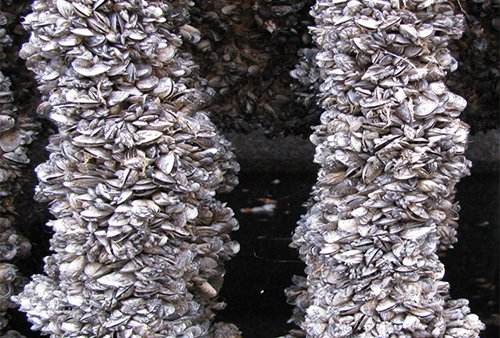
|
Freshwater MusselsSome western mussels use native salmon to complete their life cycle, and benefit from the nutrient-rich salmon carcasses and diversity that healthy salmon runs provide. In turn, salmon and other aquatic species benefit from freshwater mussels. They serve a function like earthworms in your garden by allowing sediment to retain more organic matter and by increasing sediment porosity (For more, see Freshwater Mussels of the Pacific Northwest.) Work conducted by the Confederated Tribes of the Umatilla Indian Reservation focuses on the long-term goal of restoration of freshwater mussels to the Umatilla River basin and other ceded subbasins as part of ongoing efforts to rebuild ecosystem diversity, function, and traditional cultural opportunities in the region. |



